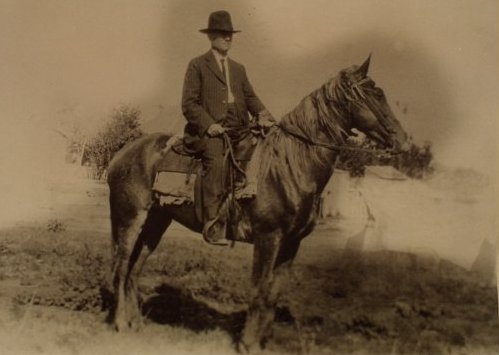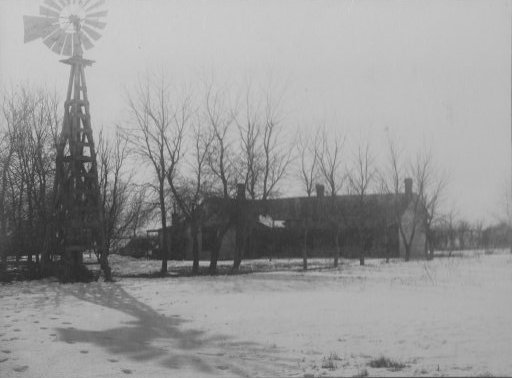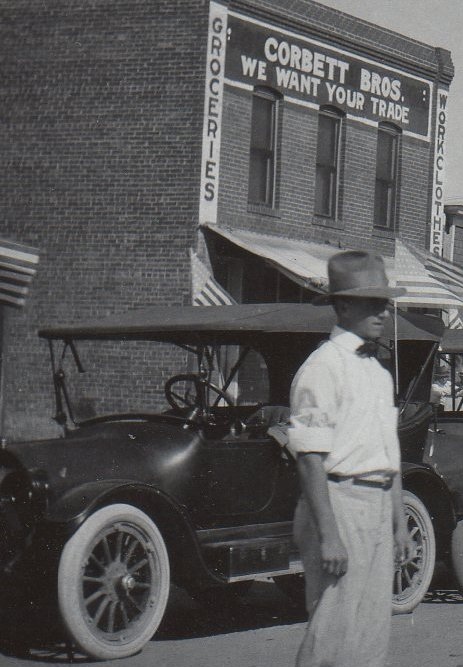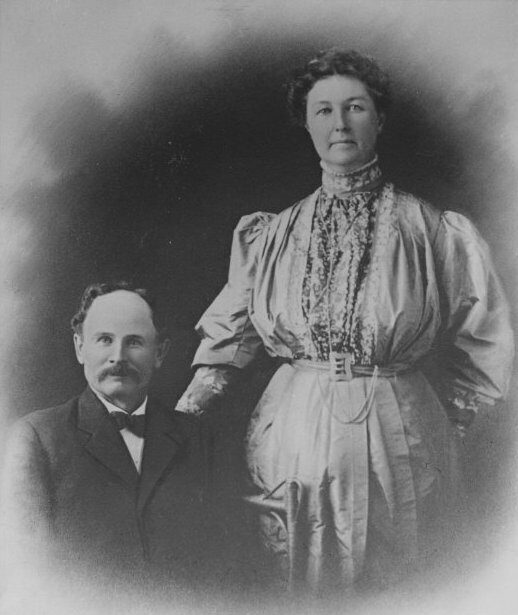As one of the first residents of the Deerfield area, Samuel Harrison Corbett was deeply interested in the welfare of Deerfield and its citizens. A highly respected and a prominent member of the agricultural community, Sam was widely and favorably known as a man of sterling worth and a worthy representative of the courageous pioneers who settled the county. In fact, Corbett was once referred to as the number one citizen of the Deerfield Community by Foster Eskelund, a life-long Kearny Countian and former president of the Kearny County Historical Society. Born at Baltimore, Maryland in 1859, he was but 12 years old when his father died unexpectedly. Sam went to Boonsboro, Maryland to live with an uncle and remained in his home for a year. Later he spent two years at Sharpsburg where he rose at 4 a.m. every day to do chores and repeated them each evening after school. In return, Corbett received his board and clothes and $30 a year.
In 1877, Sam left to seek his fortune in Kansas and lived in both Lincoln and Graham counties where he worked for claim holders for board and the barest of wages. He survived on two meals a day with supper being a steady diet of only mush and milk. Sam grew extremely homesick but couldn’t gather enough money to return to the East. He started with a caravan to Silver Cliff, Colorado in 1880; however, when the group arrived at Fort Wallace, Corbett decided instead to remain there and become a sheep herder. He eventually made his way to the Arkansas Valley where he gained employment as a cow punch for the XY Ranch. He traversed the XY’s range from Garden City west to Hartland, and the spring round-ups brought him in contact with almost every hill and vale within a radius of 250 miles. That was a dangerous time, and the ranch boys had to stay on high alert. Sam grew to know all the country, the cowboys, ponies and brands from the Adobe Walls region to the Smoky Hill River and loved the stories the cowboys told around the camp fires on the open plains or sheltered from the storms in the sod bunk house at ranch headquarters.

After four years with the XY, Corbett intended to make a business of catching mustang ponies; however, his plans were changed by a charming young lady whom he wooed and won. In 1883, he married Miss Dolly Caswell who came to Deerfield in 1882 with her widowed mother. Instead of chasing ponies, Sam filed on a piece of land and established his home on the southwest quarter of section 16, township 24, range 35. He built his bride a 14×20-foot box house which was then considered a “mansion” in this section of the country. As his wealth increased, Mr. Corbett added to the house until a one-story dwelling of seven rooms sheltered he and Dolly and their six children.

While working for the XY, Corbett started building up his own ranch; thus, he had a small bunch of cattle to start with when he assumed possession of his ranch. After losing his entire herd in the great blizzard of 1886, Sam borrowed $150 and began buying and selling condemned cow horses. Stock raising became a highly profitable endeavor for Sam, and his tenacity helped to develop the open prairie from a cattle range to a fine agricultural paradise.
Corbett was also a highly successful business man. In 1902, he went into business with Fred Sower, purchasing the grocery house of George H. Tate at Deerfield. Corbett & Sower dealt in general merchandise and groceries, selling everything from pitch forks to “Moses’ best flour.” Sam bought out Sower in 1904 and built a new store building in 1907, advertising as “the old reliable.” Corbett’s store was a gathering place for nearly every resident of the city. He also continued to sell cattle and horses and raise hay on the side. Following his retirement, Sam and Dolly moved to Colorado Springs in 1918.

Sam Corbett never took an active part in political affairs, but he served as clerk of the first school board of the township. He also served as Deerfield postmaster for over five years and was instrumental in establishing a rural route with over 80 boxes on it. Although he was raised under Catholic influence, Sam became a Sunday school leader and active member of the Methodist Church to which his wife and children belonged. He was also a wide reader of history, both ancient and modern. During retirement, Sam wrote stories of his life on the range and sent them with letters to his friends. Samuel Harrison Corbett died in 1931, and his body was brought back to Kearny County for burial in the Deerfield Cemetery. Dolly died in 1949 and was buried in Evergreen Cemetery in Colorado Springs.

SOURCES: A Standard History of Kansas and Kansans by William E. Connelley; Diggin’ Up Bones by Betty Barnes; Southwest History Corner by India H. Simmons; History of Kearny County Vol. 1; Museum archives; and archives of the Kearny County Advocate and Hutchinson Gazette.


